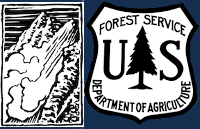Doug Chabot inspects the crown of the 3-4 foot deep, soft slab avalanche. It was on a northeast facing slope and fractured on a thin layer of small-grained facets. The slope angle was 35-37 degrees. Photo: B. Fredlund.
13-14
The left avalanche was approximately 150 feet wide and ran 320 feet vertical. Photo: B. Fredlund
This small natural avalanche was adjacent to the two bigger slides. Small avalanches are Mother Nature's red flags that similar slopes are unstable. Photo: B. Fredlund
It appears that the right avalanche was triggered by a snowmobiler on Wednesday, which also released the smaller slide on the left sympathetically. Buried facets 50cm off the ground were the weak layer. Photo: B. Fredlund
These avalanches released early in the week after the larege snowstorm: north to northeast facing slopes that likely ran on faceted snow 1-2 feet off the ground. Photo: B Fredlund
GNFAC Avalanche Advisory for Wed Dec 4, 2013
Cooke City
This slide was triggered by the Big Sky Ski Patrol on the north side of Lone Mountain (formerly Moonlight Basin). It broke about 3 feet deep on facets near the ground. This slide was triggered with explosives, and it is notable because it occurred on a slope that has no history of producing avalanches. Photo: Big Sky Ski Patrol
Forecast link: GNFAC Avalanche Advisory for Wed Dec 4, 2013
This natural avalanche was one of at least 20 observed on Tuesday, Dec 3 near Cooke City following a storm that deposited 3 inches of snow water equivalent which was over 2 feet of heavy snow. Photo: B. Fredlund
Forecast link: GNFAC Avalanche Advisory for Wed Dec 4, 2013
